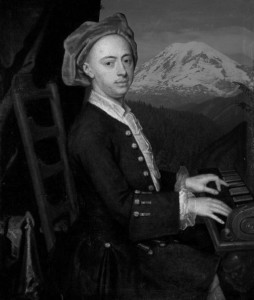It’s not by any means the whole Megillah, but like the woman at the heart of the Purim story, the Baroque oratorio “Esther” made history. With its premiere, it introduced to the world a new musical form: The English-language oratorio, a grand creation for chorus and orchestra. Its composer, George Frideric Handel, would go on to delight London audiences with many more such entertainments based on scriptural verses — most famously, “Messiah,” its frequent December companion, “Judas Maccabaeus,” and that springtime favorite, “Israel in Egypt.”
Handel’s “Esther” will be performed Sat., March 26 at St. James Cathedral, as a crowning moment in the final weekend of this month’s American Handel Festival in Seattle. The festival has brought together early-music scholars, fans of Baroque music, and dozens of Seattle-area music groups for some 30 performances over 17 days. Using the rarely heard original 1720 version of the much-revised “Esther,” the esteemed early-music specialist Stephen Stubbs conducts Pacific Musicworks, with the Tudor Choir conducted by Doug Fullington.
This performance “will provide the first opportunity since 1720 to hear the oratorio performed in a version as close as we are likely to get to its original form,” according to Handel scholar Graydon Beeks of Pomona College. (Read his whole essay on the creation of “Esther” at www.americanhandelfestival.org.)
“Esther” was first performed in a small theatre at the country estate of Handel’s patron, the Duke of Chandos. Its original name may have been “Haman and Mordecai: A Masque.” The English text (the libretto) by Alexander Pope and John Arbuthnot, is based on Racine’s French translation of the Hebrew original, but despite all those layers, the story line pays fairly faithful attention to the middle of the Megillah. A 1715 English translation of Racine’s 1689 play seems to have been a hot literary item in its day.
The librettists did chop off the beginning and the end: No Vashti at the start, no messy battles at the conclusion. The whole thing is bookended by joyous choruses: Hooray for our gal Esther, promoted to queen; hooray for our gal Esther, triumphant over Haman. In between, in one continuous act lasting just over an hour, there’s musical drama in those arias: Haman, a deep bass voice, intones his evil plans (“Pluck root and branch”); Mordechai, a tenor, comforts Esther (“Dread not, righteous queen”); and Esther, a soprano, of course, gets a fine fainting scene on her approach to Ahasuerus. The choruses, “whether of rejoicing or mourning, are musically distinguished and dramatically apt,” as Beeks writes in notes to a Collins Classics CD.
Music piracy goes back all the way to Handel’s “Esther”: its first public performance, from a pirated manuscript, motivated the composer to greatly revise and expand the work. It’s this later version that is usually performed today, making the Seattle performance a rare opportunity.
Some 40 years after Handel’s English “Esther,” the story underwent another round of linguistic and musical adventures: this time it was a Hebrew-language oratorio, based on the same English translation Handel used, based on Racine’s popular French version of the Megillah story. The composer was one C.G. Lidarti, Viennese-Italian, not Jewish; the Hebrew-language librettist, Jacob Raphael Saraval, Rabbi of Venice and Mantua, writing for the Jews of Amsterdam and London. The manuscript of this 1774 score reportedly was unknown until someone stumbled onto it in the Cambridge University Library in 1998. That might be an interesting follow-up project for the early-music scholars and performers involved in Seattle’s “Esther.”
Getting a Handel on the story of Esther
